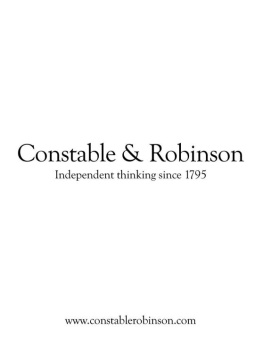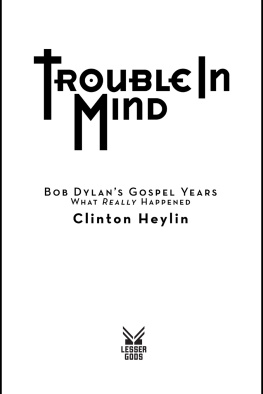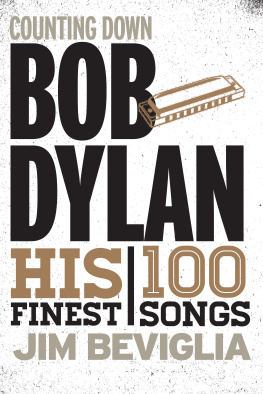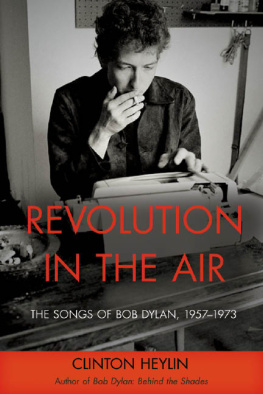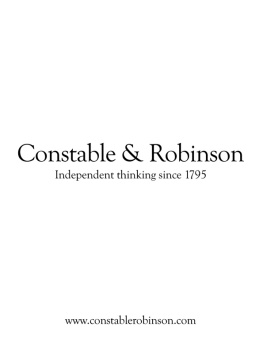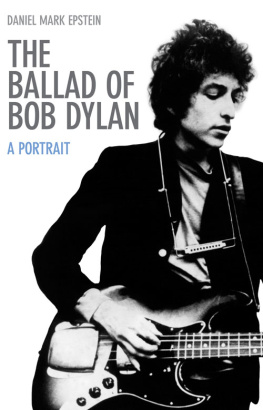STILL ON THE ROAD
Also by Clinton Heylin:
So Long As Men Can Breathe: The Untold Story of Shakespeares Sonnets
Revolution in the Air: The Songs of Bob Dylan Vol. 1 (195773)
The Act Youve Known for All These Years: A Year in the Life of Sgt. Pepper & Friends
Babylons Burning: From Punk to Grunge
From the Velvets to the Voidoids: The Birth of American Punk
All Yesterdays Parties: The Velvet Underground in Print 196671 [editor]
Despite the System: Orson Welles Versus the Hollywood Studios
BootlegThe Rise & Fall of the Secret Recording Industry
Can You Feel The Silence?Van Morrison: A New Biography
No More Sad Refrains: The Life & Times of Sandy Denny
Bob Dylan Behind The ShadesTake Two
Dylans Daemon Lover: The Story of a 450-Year-Old Pop Ballad
Dylan Day by Day: A Life in Stolen Moments
Never Mind the Bollocks, Heres the Sex Pistols
Bob Dylan: The Recording Sessions 196094
The Great White Wonders: A History of Rock Bootlegs
The Penguin Book of Rock & Roll Writing [editor]
Gypsy Love Songs & Sad Refrains: The Recordings of Sandy Denny & Richard Thompson
Rise/Fall: The Story of Public Image Limited
Joy Division: Form & Substance [with Craig Wood]
STILL ON THE ROAD
THE SONGS OF BOB DYLAN, 19742006
Clinton Heylin

To Tony Lacey, for twenty years of friendship and faith.
Interior design: Sarah Olson
2010 by Clinton Heylin
All rights reserved
First edition
Published by Chicago Review Press, Incorporated
814 North Franklin Street
Chicago, IL 60610
ISBN 978-1-55652-844-6
Printed in the United States of America
5 4 3 2 1
{ Contents }
{ Just Like Another Intro }
I never opened up my own thinking. My stuff was never about me, per se, so everybody who thought it was about me they took the wrong road.Dylan, 2007
Im not a playwright. The people in my songs are all me.Dylan, 2009
Still on the Road, the sequel to my previous volume on Dylans songs, Revolution in the Air, tells quite a different tale. Like that volume, its nature is dictated by the material it addresses, as it tells the stories of the next three hundred songs. But whereas the first three hundred songs were essentially written in a thirteen-year period, it took the man some thirty-three years to complete this second series. As a result, the songs herein are intersected by several periods of creative abeyance which last anywhere between six months (the first halves of 1975 and 1977, the second half of 1981) and six years (19916).
Nonetheless, both books share the key structural aspecteach is divided into two blocks of creative time: the first, when songwriting generally came easily and plentifully; the second, when the pipes got rusty, and supply became intermittent at best. In that first volume, the period 19617 saw Dylan write 236 songs in the white heat of inspiration, and a mere 52 songs in the years from 1968 to 1973the so-called amnesia (see my discussion in Behind the Shades, pages 29496). The differential is not quite so acute in this second volume, but the book still ends up being divided between the 163 songs he wrote (or cowrote) in the years 197483, and the remaining 137 songs, which occupy the years from 1984 to 2006.
I would personally argue that the years 1974 to 1983 saw Dylan write as many great songs as he managed in those wild mercury years. After reestablishing his genius credentials with the devastating Blood on the Tracks, he reinforced them with Desire and completed the cycle with perhaps his most lyrically ambitious work to date, Street-Legal, before surrendering himself to God. A trilogy of testaments to his newfound faith followed (Slow Train Coming, Saved, and Shot of Love), before he signed off on those halcyon days with the 1983 comeback album, Infidels, which for all its (largely self-inflicted) flaws, again proved that no one wrote Dylan quite like Dylan.
But what truly marks out these years for Dylan the singer-songwriter was how, on every occasion he entered the studio to record an album, he always had the material to make a classicjust like the early-to-mid-sixties. The fact that he only managed to transfer such potentially first-class material onto tape in fits and starts, limiting himself to just two truly classic albums in this ten-year period, Blood on the Tracks and Slow Train Comingand a couple of close calls, in Street-Legal and Infidelsdoes not devalue his output as a songwriter one jot. I would go as far as to argue that if Dylan emerged fully formed in 1974, with no track record to date, his body of work in just those ten years would still make him the most important songwriter of his generation.
Thankfully, because of the likes of the Blood on the Tracks notebook; the recollections of his collaborator on Desire, Jacques Levy; a December 1977 piano run-through of the Street-Legal material; and Dylans determination to debut material in rehearsal at Rundown through 1981, ordering the songs by composition remains a viable methodology all the way up to Shot of Love. After that, Infidels may be a crapshoot, but from 1984 to 1990 we return again to surer footing, thanks in part to Dylan resuming recording his songs in a series of sessions, rather than in a single block. The exceptionOh Mercyis also the one instance where Dylans own Chronicles comes to our aid.
After 1983, though, the process itself starts to distend. Rather than the one writers block of the late sixties and early seventies, Dylan became more and more inclined to bouts of creative forgetfulness. But, for all that, he had by no means written his last great song. Even during the remainder of that erratic decade, he still found the wherewithal to compose the likes of New Danville Girl, When the Night Comes Falling From The Sky, Tweeter and the Monkey Man, Most of the Time, Shooting Star, Dignity, and Series of Dreams, all songs which no other songwriter could have conjured.
But as he told one familiar interviewer in 1991, as the most severe of his writers blocks set in, There was a time when the songs would come three or four at the same time, but those days are long gone. After a lull that lasted the first half of the nineties, he finally returned in 1997 with Time Out of Mind, the first in another trilogy of critically acclaimed albums dealing with mortality and fear, further advanced via Love and Theft (2001) and concluding in 2006 with Modern Times.
The difference now was thateven with longer and longer gaps between albumshe almost never came to the studio with enough of the kind of songs required for a classic collection. And, in fact, both times in the past two decades when he did manage such a coupOh Mercy and Time Out of Mindhe was so overwhelmed by producer Daniel Lanoiss intrusive role in the process that he allowed the opportunity to slip from his grasp.
Lanois is not the only one who has failed to understand the artists instinctual approach in a studio situation and/or has sought to impose an unsuitable sound on this last bastion of live in studio recording. When Dylan told assembled journalists at a 2001 press conference, I have often been let down. All those people who thought they knew how to record me hadnt the slightest idea about what needed to be done, I imagine Arthur Baker and Mark Knopfler loomed as large in his mind as Mr. Ambient.
Next page

